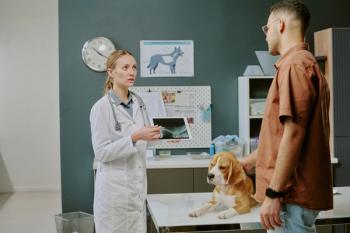
5 key steps to managing chronic kidney disease
ADVERTISEMENT Many interventions are available to help delay the progression of this serious disease and maintain quality of life for those patients in the latter stages.
Chronic kidney disease (CKD) is a common disease in older animals, affecting about 6% of cats and 1% of dogs,
with the incidence increasing dramatically to around 15% in cats older than 15 years. To facilitate management recommendations for these patients, the International Renal Interest Society (IRIS) has developed a
• Stage I includes nonazotemic pets. Clinical signs of uremia will not be present and history may suggest a tendency to develop CKD in the future because of a previous insult to the kidneys. Management involves monitoring the primary condition (if known), blood pressure, and urine protein levels and addressing appropriately.
• Most pets with Stage II CKD show mild clinical signs or are asymptomatic and have mild elevations in blood urea nitrogen (BUN) and creatinine concentrations. Most patients will maintain body weight and hydration and may not need specific treatment. Monitoring hydration, blood pressure, proteinuria, and phosphorus is highly recommended and abnormalities require specific treatment if present.
• Pets with Stage III disease usually have some clinical signs, which may include polyuria and polydipsia or partial anorexia, among others. More intervention is typically needed for these animals.
• Most pets with Stage IV CKD have marked clinical signs. Pets with Stage IV CKD may develop a uremic crisis, characterized by acute decompensation with dehydration and marked clinical signs, and they will need to be hospitalized for treatment. If they are stabilized, they can be sent home to continue outpatient management.
Here are five important steps you can take to manage CKD in your canine and feline patients.
1. Work with clients to provide nutritional management
Renal diets: Use of a renal diet that manages protein and phosphorus clearly increases survival time in dogs, which makes it one of the most potent treatments for CKD. Similar effects are seen in cats eating a renal diet.
Supplements: Management of renal toxins as early as possible can help maintain quality of life. As soon as BUN and creatinine reach unhealthy concentrations, steps should be taken to manage them. Supplementation with beneficial bacteria that digest specific enteric toxins can help manage uremic conditions. This approach is compatible with other therapies, and patients can experience quality of life improvements in as little as four to five days.
Appetite stimulants: Appetite stimulants are sometimes helpful in managing pets with CKD. The food needs to be available, as onset of the action from the appetite stimulant can be rapid. Administration can jump start the appetite sufficiently to result in sustained eating.
Enteral feeding: If the pet will not consume enough food voluntarily, a feeding tube can alleviate many of the obstacles in patient management. Although many clients initially resist the recommendation to use a feeding tube, most find that the ease of administering medications and the drop in the stress related to coaxing the pet to eat make a feeding tube a welcome addition.
2. Slow progression by controlling proteinuria
Proteinuria is associated with more rapid progression and shorter survival times, so assessment of proteinuria should be standard in all animals with CKD. The urine protein to creatinine ratio (UPC) could be considered the gold standard of urine protein measurement. Any positive result on a urine dipstick test should be followed with a UPC to confirm and quantify the proteinuria.
If proteinuria is present, correction of any underlying condition such as hypertension, urinary tract infection or fever should be attempted. If the proteinuria persists and is not corrected by a renal diet, consider pharmacologic treatment.
3. Provide appropriate fluid therapy during Stages III and IV
The ability to concentrate urine is destroyed with CKD, leading to an obligate polyuria. Because of the urinary water loss, increased water intake is necessary to avoid dehydration. With advancing CKD, some cats are unwilling or unable to drink a sufficient volume of water to replace the deficits, and they become dehydrated. In turn, dehydration impairs renal toxin removal capabilities, adding a prerenal azotemia to the renal azotemia. The dehydration and the azotemia can create nausea that diminishes a cat's desire to drink, exacerbating the situation.
Encouraging water consumption in early stages may be sufficient. So talk to clients about providing fresh cold water-or settled room temperature water, according to the individual cat's preferences-multiple water bowls, running water or even flavored water. For example, you could recommend that a client try using the water from a can of water-packed tuna. If you do take this approach, however, you should review and discuss the salt and electrolyte content.
If voluntary intake is insufficient in cats or dogs, subcutaneous fluids may be helpful. And even if additional fluids are not required on an ongoing basis, they may help during periods of stress when the animal's water intake may decrease. For example, pets' regular routines are interrupted when there are visitors in house, the owners are away or during boarding. Subcutaneous fluids also may be required if the pet suffers extra fluid loss due to vomiting or diarrhea. Intravenous fluids may be required in a uremic crisis.
4. Medicate to control progression
Phosphate binders: Because the ability to excrete phosphate diminishes with decreased glomerular filtration rate (GFR), hyperphosphatemia is commonly seen in patients with CKD. Often, renal diets are a great start to control phosphorous intake. However, in some cases they may not be enough. Phosphate binders, including chitosan-based phosphate binders, are used to prevent absorption of phosphorous that is ingested with meals. They should be administered at meal time for maximal efficacy. Based on IRIS renal staging guidelines, you would recommend use as soon as phosphorus concentrations exceed 4.5 mg/dl.
Potassium: Hypokalemia is a consequence of increased loss and/or decreased intake of potassium in CKD, especially in cats. Signs of hypokalemia are muscle weakness, which differentially affects the muscles of the head and neck first. These cats may present with profound cervical ventroflexion. The chronic hypokalemia promotes metabolic acidosis, and both the hypokalemia and acidosis promote progression of renal damage. A palatable oral supplement can help manage potassium deficiency in dogs and cats and improve quality of life. If severe, IV potassium may be needed to correct levels in a uremic crisis.
Decreasing gastric acidity: Gastric ulceration is a common problem with chronic kidney disease. Histamine blockers and proton-pump inhibitors are routinely used as anti-ulcer medications.
Antiemetics can be used as needed.
5. Focus on appropriate monitoring
Frequency of monitoring depends on the patient's clinical condition. If there are ever questions about a pet's stability or a change in the status, a recheck is always in order. The benefit of routine monitoring in pets that appear normal to the owners is that many conditions can be detected and treated before clinical signs develop.
For Stage II disease that is relatively asymptomatic (good appetite, maintaining weight, receiving minimal treatments), patients should undergo a recheck visits that include a physical examination, weight check, serum chemistry profile and complete blood count every six months.
Pets with Stage III disease that are stable with treatment should be checked every two to three months. Pets with Stage IV CKD or those receiving subcutaneous fluids on a daily basis should be checked monthly. Urinalysis and urine culture should be performed at least twice a year in all stages. Blood pressure measurement should be performed every three months in hypertensive pets that are controlled on therapy.
Keep in mind, outcomes are extremely difficult to predict for an individual animal. So helping your clients set realistic expectations is an important part of case management. And offering them steps they can take to control their pets' quality of life in ways that are manageable and sustainable is an important part of your role in protecting their pets' health and their bonds.
Newsletter
From exam room tips to practice management insights, get trusted veterinary news delivered straight to your inbox—subscribe to dvm360.




